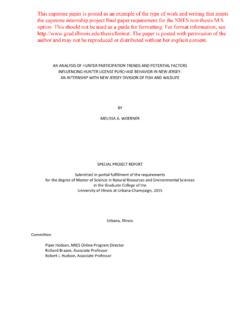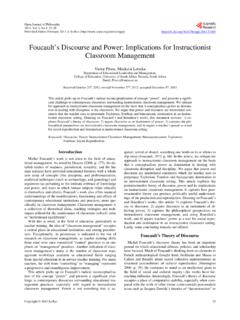Transcription of This capstone paper is posted as an example of the type of ...
1 USING Q-METHODOLOGY TO UNDERSTAND ENVIRONMENTAL OPPOSITION TO FRACKING BY DANIELLE M. MCLAUGHLIN capstone PROJECT Submitted in partial fulfillment of the requirements for the degree of Master of Science in Natural Resources and Environmental Science in the Graduate College of the University of Illinois at Urbana-Champaign, 2016 Urbana, Illinois Master s Committee: Assistant Professor Bethany Brooke Cutts, Research Director Piper Hodson, Director of the NRES Online Program Associate Professor Lulu Rodriguez This capstone paper is posted as an example of the type of work and writing that meets the capstone individual research project final paper requirement for the NRES non-thesis option. This should not be used as a guide for formatting. For format information, see The paper is posted with permission of the author and may not be reproduced or distributed without her explicit consent.
2 IiABSTRACT The recent expansion in the development of unconventional sources of natural gas in the United States, specifically the Marcellus Shale-rich state of Pennsylvania, has generated policy and public controversy. The media discourse about fracking in central Westmoreland County has often been negative, based on media coverage, newspaper articles, and the development of numerous opposition groups. This study uses Q-methodology to examine emergent perspectives and sub-discourses within the fracking opposition debate in central Westmoreland County, PA. The analysis reveals four different narratives of perspectives amongst people actively involved in locally opposing fracking, labeled (1) Future Fears; (2) Local Resistor (3) Community Concerns; and (4) Distrust Stakeholders and Turn towards Renewables. The conflicts that emerge across these four extracted factors are indicative of deeper discourse within the fracking debate that signifies diversity in motivations, values, and convictions.
3 The disparity in viewpoints point to fundamental disagreements over standard fracking processes, stakeholder decisions, and the future of fracking. Unraveling these core areas of dissent can offer tangible data upon and insights which policymakers can base future fracking campaigns. iiiTABLE OF CONTENTS LITERATURE RESEARCH METHODS ..16 RESULTS ..20 STUDY LIMITATIONS AND SUGGESTIONS FOR FUTURE APPENDIX A: CONCOURSE APPENDIX B: CONCOURSE APPENDIX C: CRIB 1 INTRODUCTION The recent energy revolution to develop unconventional sources of natural gas in the United States has generated policy and public controversy. The advancement of hydraulic fracturing technology in unconventional horizontal drilling and the development of natural gas resources has expanded the United States gas supplies (Olmstead et al.)
4 , 2013). The main source of unconventional natural gas in the northeast United States is the Marcellus Shale formation that spans the states of Pennsylvania, Ohio, New York and West Virginia. The Marcellus Shale is a very fine grained, impermeable rock that has methane gas distributed throughout it. The fracking procedure injects chemicals, sediments, and water at a high pressure into the shale bed to mechanically fracture the bedrock and facilitate recovery of natural gas (Boudet et al., 2014). The purported advantages of utilizing natural gas include lower carbon dioxide emissions and less associated pollution in comparison to oil and coal, increased jobs and economic growths to local fracking areas, and the vast resources available within the United States (Davis, 2012; Bolinger, 2014; Boudet et al., 2014).
5 However, there are local concerns of environmental contamination, health hazards, a lack of proper setback distances (the distance of fracking sites from homes, occupied buildings, water bodies, etc.), and perceived general untrustworthiness of fracking companies (Boudet et al., 2014). The state of Pennsylvania is a central player in the evolving understanding of fracking given its vast shale deposits, resource development opportunities, media coverage, and its maintenance of a consolidated and centralized natural gas policy regime, rarely susceptible to local influence (Rabe & Borick, 2013). Fracking as a way of releasing natural gas has recently generated considerable controversy in central Westmoreland County, PA. In the past several years, fracking has spread throughout Westmoreland County, drilling permits have been issued in other Pennsylvania townships, and wells continue to be proposed throughout the area (Amico et al.)
6 , 2011). The local public sentiment surrounding fracking has often been negative, judging by media s coverage of fracking activities, local newspaper articles, and the development of numerous opposition groups. In an aim to understand public opposition to fracking, this study applied Q-methodology to explore the themes and sub-discourses of fracking opposition in a region of the United States actively fighting fracking, proposed permits, and further expansion of fracking sites. The ability to improve the fracking debate beyond entrenched positions of support or opposition while unraveling the core 2areas of dissent can provide local policy-makers with policy objectives and tangible data upon which to base future fracking campaigns. 3 LITERATURE REVIEW Hydraulic fracturing (fracking) is a technique employed to harness previously untapped natural gas.
7 The process couples horizontal drilling with high-pressure injection of chemicals, sediments, and water that mechanically fractures bedrock (typically shale) to facilitate the flow of gas through the fractured rock fissures (Boudet et al., 2014). Fracking is a dynamic and comprehensive process that inevitably alters the economic, environmental, social, and health fabric of local communities (Jacquet, 2012; Boudet et al., 2014). Over time, however, the practice has met public disapproval and resistance. Typically, public support for fracking stems from associated job growth and local economic stimulation (Davis, 2012; Bolinger, 2014; Boudet et al., 2014). Fracking has created approximately 245,000 direct and indirect jobs in the state of Pennsylvania, injecting tens of billions of dollars directly and indirectly into the state s economy (Meng, 2015).
8 Proponents also extol the virtue of harnessing natural gas, which emits less greenhouse gases into the atmosphere compared to oil and coal, and has lessened the United States dependence on imported sources of energy (Eaton, 2013; Paredes, Komarek, & Loveridge, 2015). Natural gas is seen as a transition fuel towards a renewable energy future and low natural gas prices, supplemented by increased availability, ultimately reduce consumer costs, makes electric vehicles a viable alternative, and reduces the country s reliance on petroleum products (Ansolabehere & Konisky, 2012; Eaton, 2013; Paredes, Komarek, & Loveridge, 2015). Conversely, public opposition for fracking typically stems from perceptions of environmental contamination, health risks, and halting of renewable energy sources (Davis, 2012; Bolinger, 2014; Boudet et al., 2014). Potential environmental impacts include water contamination from the chemical additives in fracking fluid injections, air pollution from volatile organic compounds (particularly methane) that contribute to global climate change, seismic risks, noise pollution, and soil contamination from radioactive materials in waste products fracking generates (Lampe & Stolze, 2015; Merril & Schizer, 2013).
9 In Pennsylvania, individual fracking wells produce approximately 1,000 tons of drilling waste (ground up rock and drilling mud) that may contain salts, heavy metals, and naturally occurring radioactive materials (Merril & Schizer, 2013; Lampe & Stolze, 2015). Over the course of a well s lifetime, nearly of shale gas production 4migrates to the atmosphere through venting or leaking and 37% of the chemicals used during fracturing have been found to be volatile and airborne (Howarth, Ingraffea, & Engelder, 2011; Jackson et al., 2013; Caulton et al., 2014; Meng, 2015). Expected to account of 49% of the United States natural gas production by 2035, fracking has thus prompted industry leaders, governments, and researchers to monitor public perception. There is a need to understand the reasons behind people s support or opposition to effectively tap the full potential of natural gas reserves, engage relevant stakeholders, and develop responsible policy (Boudet et al.)
10 , 2014). Extant literature on public opinions to fracking and environmental and energy initiatives have been covered from various perspectives, including the geographic distribution of fracking operations (Greenberg, 2009; Theodori, 2009), their impact on the environment vs. the economic benefits that can be derived from them (Theodori, 2009), comparative studies of cases (Jacquet, 2012; Stedman et al., 2012; Boudet et al., 2014; Davis & Fisk, 2014; Kriesky et al., 2014), and demographic and psychographic characteristics of people who typically support or oppose fracking (Finucane et al., 2000; Dunlap, Xiao, & McCright, 2001; Xiao & McCright, 2001; Smith, 2002; Konisky, Milyo, & Richardson, 2008; Semenza et al., 2008; Boudet et al., 2014; Davis & Fisk, 2014; Kwan, 2012; Liu, Vedlitz & Shi, 2014). Prior research has been largely empirically driven and employed two main types of methodology-public opinion polls or surveys and case studies of specific energy projects.




